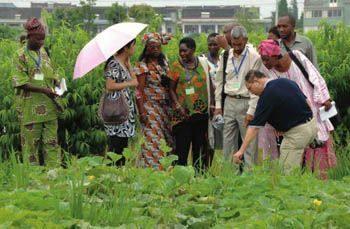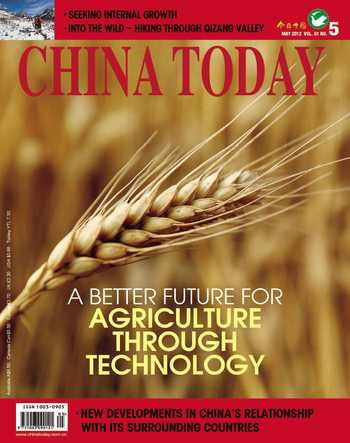China’s experience of agricultural Cooperation
LI YUAN

WU Liangyong, a prominent Chinese expert on architecture and urban planning, once said, “You cant imagine industry without the support of agriculture, or urban life without any connection with the countryside.”
As the global economy becomes more integrated, international communication about agriculture is growing and, with its massive import and export volume, China is no small player. Its international cooperation on agriculture is becoming increasingly influential in its primary sector development, evolving from focusing on trade, attracting foreign investment and importing technologies to establishing farms abroad, exporting domestically-developed facilities and technologies and participating in the formulation of international agricultural rules.

Farm Produce exports
In international agricultural cooperation, the trade of farm produce is a central issue. China is both the worlds largest producer and consumer of farm produce, and a major agricultural exporter.
Since its entry into the WTO, Chinas share of world farm produce exports has been increasing year by year, from 2.9 percent in 2001 to 3.8 percent in 2010. Its export value on farm produce rose to US $60.75 billion in 2011 from US $16.07 billion in 2001. As of now, China has become the worlds fifth largest exporter of farm produce and the fourth largest country in terms of trade volume. China is exerting ever-greater influence on the international agricultural market.
With a large population and limited arable lands, China has a comparative advantage in labor-intensive products, such as fruits, vegetables, animal and aquatic products, and its export volumes are huge. For such land-intensive products as soybean, cotton and vegetable oil, however, China is reliant on imports.“This shows that China is taking advantage of and participating in international division of labor,” said Wang Ying, chief of the International Cooperation Department of the Ministry of Agriculture.
He also pointed out that currently the competitive edge of Chinas agricultural products lies in their relatively low prices, but that as exports from other labor-rich, land-poor countries and costs of domestic production increase, this advantage will gradually disappear. China should therefore turn away from its old strategy of price competition and adapt to the changing international agricultural landscape.
In 2011, the increase in Chinas imports of farm produce outstripped that of its exports, a trend that has been continuing for some time. China has seen an agricultural trade deficit since 2004.
In November 2011 the WTOs Fourth Ministerial Conference officially launched the Doha Round, the latest round of trade negotiations among the organizations member states. Agriculture has taken center stage in the talks, the most contended issues being market access, domestic support and export subsidies. Owing to persistent wide differences between member countries, however, an agreement has yet to be reached.
“The failure of the Doha round of negations on free trade for agricultural products indicates that, in the short term, it will be difficult to achieve a greater degree of multilateral trade liberalization, but regional integration and cooperation will expand,”Wang said. “China and most other countries have been trying to create a fair and free international environment for multilateral trade. China has hence been seeking to establish free trade zones with countries and regions that produce complementary agricultural products. This will help China to expand its export market, discover more reliable sources of imports and achieve reciprocity and shared benefits in agricultural trade.”
On a similar note, on March 19, 2012, Pascal Lamy, directorgeneral of the WTO, announced that it had become impossible for the Doha Round of negotiations to achieve its goals, but that it could make progress on reaching international agreements on such aspects as forming common laws to facilitate the crossborder flow of products.
overseas Agricultural Investment
In August 2011, the first feedstuff manufacturing plant invested by Chinas private enterprise New Hope Group officially began its operation in Cambodia. Cambodian Minister of Agriculture, Forestry and Fisheries Chan Sarun attended the opening, extending his personal congratulations and saying that this project shows that Chinese enterprises have full confidence in Cambodias investment environment. The New Hope Groups plant, he said, will play an important role in promoting Cambodian poultry and livestock breeding industry.
China has been investing in agriculture abroad for over 20 years. Most of the investment comes, directly from Chinese enterprises, and has covered activities such as offshore fishing, crop cultivation and agricultural product processing in every continent except Antarctica. Such investment has been growing alongside rapid development of Chinas economy and its enterprises strength.
The total accumulated value of Chinas foreign direct investment in farming, forestry, animal husbandry, sideline production and fisheries more than tripled in the period between 2004 and 2010.
According to Chen Xiwen, director of the Office of Central Rural Work Leading Group, equality and mutual benefit and cooperation have been the guiding principles for Chinas overseas investment. On the Chinese side, enterprises investment abroad has helped expand their access to the international market and made China better able to take advantage of international resources and participate in international cooperation. Recipients of investment have also benefited. The capital and technology they have received from China have greatly improved agricultural development and employment in these countries, which have been mostly in regions and countries with undeveloped agriculture.
The New Hope Groups operation in Cambodia is a good example. All of the feed produced by the factory there is sold in the local market, feeding local livestock, and 90 percent of its employees are local. Once the factorys operation has stabilized and matured, the group will reduce the proportion of its Chinese employees working there. For New Hope, one of Chinas largest feedstuff processing enterprises, overseas investment has been about securing sustainable development, and the Cambodian feedstuff factory is its seventh factory in Southeast Asia.
In recent years both the number of Chinas enterprises making overseas investments and the sheer volume of their investment in agriculture have been on the rise. “The key to successful overseas operations lies in enterprises ability in cross-border operation,” said Long Guoqiang, director of the Research Department at the State Councils Development Research Center. Long named issues critical for that success, from financing, recruiting management and outsourcing to local businesses, social responsibility, emergency planningand maintaining good relationships with local governments and the public.
Liu Yonghao, president of New Hope Group, agrees that Chinese companies face many challenges when setting up operations in a foreign country.“One third of New Hopes overseas businesses are located in Southeast Asia,” he said. “But in spite of their huge market potential, there are also many complicated problems in these areas. Different countries have different policies, laws, languages and customs. For example, if you want to buy a piece of land in Bangladesh, you have to go through over 20 procedures. Its very troublesome. One American company gave up after spending three months investigating the local market and business environment. Our willingness to deal with these challenges is one advantage of Chinese enterprises.”
Liu also thinks that in the current economic situation financing is far more important than land and labor, the two key resources in traditional agricultural business. Compared with other industries, the industrialization of agriculture takes a lot longer and is much more complex, with a high requirement for infrastructure. New Hopes good credit and relationship with transnational banks allow it smooth access to the funding needed for international expansion.
Despite increasing involvement overseas from companies like New Hope Group, Chinas overseas investment in agriculture is still in its infancy and on a relatively small scale. At present, the Chinese government is trying to change this, drawing up policies to encourage its agribusinesses to explore markets beyond its borders.
International Technology exchange
Technologies imported from other countries, including plastic mulching and drip irrigation, have done much to increase Chinese agricultures efficiency, and the sectors development is inseparable from international technology exchange. Since the founding of the PRC, most of the technologies employed in Chinese agriculture have been a result of international exchanges, first introduced from abroad and then adapted, evolving into what we see today.
Imported technologies are estimated to have sped up Chinas agricultural research and development by some 10 to 15 years and to have saved 30-50 percent of what the government would otherwise have spent on it. Today, China continues to import agricultural technologies from developed countries, while at the same time bringing agricultural technologies to other developing countries, helping them shake off their own poverty.
In June 2003, China sent nine agricultural experts to the Philippines, and provided the country with US $2.6 million for a research center on rice technology cooperation. According to its Chinese manager Cheng Liangji, the center has two clear goals in mind. The first is to help locals develop and promote the use of hybrid rice, and the second is to encourage the use of modern agricultural machinery.
Rice is one of the main agricultural products of the Philippines, but because of the low-grade seeds and relatively backward cultivation technologies used in the country, the output was small and unable to be self-sufficient. Since the project was implemented, 40 hybrid breeds, around 50 percent more productive than local ones, have been successfully introduced to the Philippines. Before this, farmers incomes were low, so when they saw the increased productivity of Chinese rice, it immediately gained popularity.
China has also exported small agricultural machines at affordable prices that meet the needs of the small farmers who make up the major body of the Philippines agricultural producers.
“Advanced agricultural technology in the developed world is the result of huge capital investment, highly skilled human resources and a mature market system, which are undoubtedly unattainable for developing countries,” said Wang Ying. “Through international cooperation, we export practical technologies to those countries, which have the potential to greatly boost their agricultural development. Our technologies are not the most advanced ones such as those used in developed countries, but we believe that suitable technologies are better.”
China has established more than 20 agricultural technology demonstration centers in Asian, African and Latin American countries under the framework of South-South cooperation, bringing its advantages in agricultural technology to less developed nations. It has also dispatched more than 20,000 agricultural experts and technicians, like those in the Philippines, to help developing countries improve their capacity in agricultural output.
China has in addition, invited agricultural officials and technicians from other developing countries to China, providing them with free training and spreading Chinas experience and expertise in agriculture around the world. So far, over 10,000 officials and technicians from over 40 different countries have benefited from such training programs.
China supports nearly 21 percent of world population with less than nine percent of the worlds arable land relying on its own strength. Brett Rierson, representative of the United Nations World Food Program (WFP) in China, called this a great contribution to world food safety. Chinas capacity and achievements in fighting against starvation at home are impressive and have drawn world attention. Twenty years ago, the WFP ran the biggest assistance program in China, but now, the country has become an important donor to the WFP, repaying the support it received. In introducing its technologies and experience in fighting against hunger to other countries, China is playing a distinctive role, and continues to polarize world attention.

